|

Autumn 2002 (10.3)
Baku's Old City
Memories
of How It Used to Be
by Farid Alakbarov
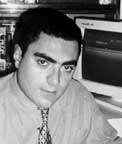  Baku's "Ichari Shahar" (literally,
Inner City), often referred to by foreigners as the "Old
City", is a unique architectural preserve that differs considerably
from the other ancient cities of Azerbaijan. Ichari Shahar [pronounced
ee-char-EE sha-HAR] has many fascinating architectural monuments,
including the Maiden's Tower and the Shirvanshah Palace, which
is currently undergoing reconstruction. But more than this, the
medieval Inner City used to have its own distinct culture and
set of traditions, many of which are starting to be lost and
forgotten. Reconstructing the ethnographic features of the community
that once lived behind Ichari Shahar's fortified walls is difficult.
Most of today's Azerbaijanis know very little about the history
and traditions of the Inner City. As the older generation passes
on, fewer and fewer people know firsthand about Ichari Shahar's
unique traditions, way of life, national clothing, holidays,
tales and anecdotes. Baku's "Ichari Shahar" (literally,
Inner City), often referred to by foreigners as the "Old
City", is a unique architectural preserve that differs considerably
from the other ancient cities of Azerbaijan. Ichari Shahar [pronounced
ee-char-EE sha-HAR] has many fascinating architectural monuments,
including the Maiden's Tower and the Shirvanshah Palace, which
is currently undergoing reconstruction. But more than this, the
medieval Inner City used to have its own distinct culture and
set of traditions, many of which are starting to be lost and
forgotten. Reconstructing the ethnographic features of the community
that once lived behind Ichari Shahar's fortified walls is difficult.
Most of today's Azerbaijanis know very little about the history
and traditions of the Inner City. As the older generation passes
on, fewer and fewer people know firsthand about Ichari Shahar's
unique traditions, way of life, national clothing, holidays,
tales and anecdotes.
Today, it would be a fair assessment to say that the Inner City's
original community hardly exists. Many of the local residents
have sold their homes and moved elsewhere in Baku and many foreign
companies have located their offices there.
Here historian Farid Alakbarov gives us a feel for what life
was once like in the vanishing community of Ichari Shahar. His
research and insight comes from sources he has discovered at
Baku's Institute of Manuscripts and from his own experiences
of growing up in the Inner City.
______
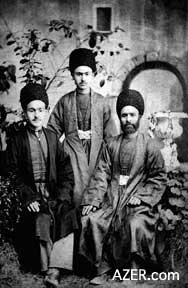  Left: The author's great grandfather, Mashadi Baghir
Alakbarov (bearded), with his two sons, the author's grandfather
Abdul Manaf Alakbarov (center) and Museyib (left) in their garden
in Ichari Shahar. All were sea captains. Abdul Manaf graduated
from the higher Naval School in St. Petersburg. The photo was
taken in 1885. Left: The author's great grandfather, Mashadi Baghir
Alakbarov (bearded), with his two sons, the author's grandfather
Abdul Manaf Alakbarov (center) and Museyib (left) in their garden
in Ichari Shahar. All were sea captains. Abdul Manaf graduated
from the higher Naval School in St. Petersburg. The photo was
taken in 1885.
I was born and raised
in Baku's Inner City, in a house in which previously three generations
of my family had lived. Ever since childhood, I have heard fascinating
stories about Ichari Shahar from my older relatives, my grandfathers
and especially my grandmothers - Hadija Kazimova, my mother's
mother, granddaughter of the famous "Gatir" Zeynalabdin,
and Ruhsara Babazade, my father's mother.
Later I began to collect stories and study various sources related
to the history of the Inner City such as "Old Baku",
a book by the distinguished Azerbaijani actor Huseingulu Sarabski
(1879-1945). Sarabski, who was born in Ichari Shahar and lived
there for many years, wrote vivid descriptions of the events
he witnessed there.
Likewise, the book "What I Saw, What I Read, What I Heard"
by the late writer Manaf Suleymanov (1913-2001) [published in
Azeri Latin in 1996 by Azerbaijan Publishing House] contains
valuable information about the Inner City. Interesting facts
may also be gleaned from the historical works, chronicles, newspapers
and documents archived at Baku's Institute of Manuscripts.
Inner City, Outer
City
According to the archeological evidence, the city of Baku dates
back to at least the early centuries AD. After 1538, Baku served
as the capital of the khanate of Shirvanshah after Shamakhi,
a city 1.5 hours north of Baku, sustained a major earthquake.
That's when the Shirvan Shahs moved their capital to Baku.
From 1747 to 1806, Baku was the capital of a khanate that included
Baku itself and 39 neighboring villages. This independent principality
was called "Badkube" (i.e. wind-beaten), "City
of Winds", and coined its own money.
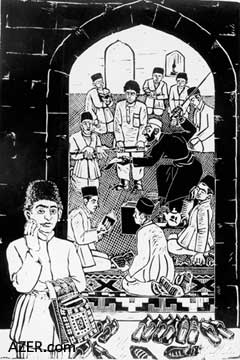  Left: The Mollakhana, the only schools that
existed in the Old City of Baku prior to the establishment of
Russian schools. Youth were beaten (see print) when they failed
at memorizing the Koran, which was in Arabic, a language that
they did not know. Left: The Mollakhana, the only schools that
existed in the Old City of Baku prior to the establishment of
Russian schools. Youth were beaten (see print) when they failed
at memorizing the Koran, which was in Arabic, a language that
they did not know.
During this period,
the entire city was located inside the fortress walls and had
a population of approximately 7,000 people. After the Russians
occupied the city in 1806, and especially during the first Oil
Boom of 1850-1920, Baku grew rapidly beyond its fortified walls.
This is when the expressions "Ichari Shahar" (Inner
City) and "Bayir Shahar" (Outer City) first came into
use. Huseingulu Sarabski writes: "Baku was divided into
two sections: Ichari Shahar and Bayir Shahar. The Inner City
was the main part. Those who lived in the Inner City were considered
natives of Baku. They were in close proximity to everything:
the bazaar, craftsmen's workshops and mosques. There was even
a church there, as well as a military barracks built during the
Russian occupation." Residents who lived inside the walls
considered themselves to be superior to those outside and often
referred to them as the "barefooted people of the Outer
City."
The Inner City consists of many small sections that are demarcated
by winding lanes and narrow streets. Originally, each section,
or block, was named after a neighboring mosque: Juma Mosque Block,
Shal Mosque Block, Mohammadyar Mosque Block, Haji Gayib Mosque
Block, Siniggala Mosque Block, Gasimbey Mosque Block and so forth.
Some of the sections of the Inner City and their mosques were
named after the clans and nationalities that lived there. For
instance, Gilaklar was the place where the merchants from Gilan
stayed; Lezgilar was the street where the Dagestani armorers
and gunsmiths lived. Most of the Inner City's residents were
craftsmen, merchants or seamen. Some of the sections took their
names from certain professions, such as Hamamchilar (Bathhouse
Owners), Bazarlar (Cloth Traders) and Hakkakchilar (Stone Engravers).
Back in 1806, there were 707 shops and craftsmen workshops in
the city, even though the total population was only 7,000. Every
merchant and skilled craftsman had his own store. Their customers
were the traders who came to Baku from various countries. Baku
ships carried goods to and from Iran, Central Asia and Russia.
Centuries - Old
Monuments
The Inner City's ancient monuments include the Maiden Tower,
the Sinig Gala Minaret (11th century), the fortress walls and
towers (11th and 12th century) and the Shirvanshah Palace (15th-16th
century). In addition, the Inner City once boasted 28 mosques,
nine caravanserais, several bathhouses, potable water reservoirs
(ovdans) and a bazaar. Merchants from Central Asia tended to
stay in the 16th-century Bukhari caravanserai, while the Indian
traders preferred the 15th-century Multani caravanserai.
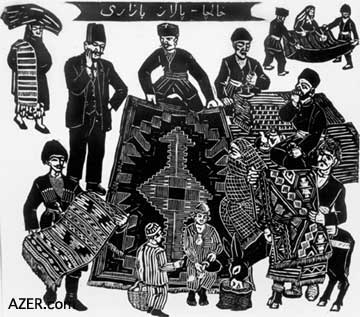  The residents of Baku were fond of bathhouses.
Besides a bath, one could get a massage, enjoy some refreshments
like cool sharbat (fruit drinks) or hot tea, have a snack or
smoke the hookah pipe there. The residents of Baku were fond of bathhouses.
Besides a bath, one could get a massage, enjoy some refreshments
like cool sharbat (fruit drinks) or hot tea, have a snack or
smoke the hookah pipe there.
Left: The Carpet Bazaar-bringing to market,
displaying and selling. Note women covered by veil.
Several of Baku's bathhouses are still standing, including the
large 15th-century Haji Gayib bathhouse behind the Maiden's Tower
and the 17th-century Gasimbey bathhouse near the Cultural Department
of the British Council.
While Baku's medieval bazaar no longer exists, you can still
see its columns and arches behind the Maiden's Tower. In the
early 20th century, the bazaar was enlarged to extend from the
Multani and Bukhari caravanserais to the 14th-century Juma Mosque.
European Styles
After the Russian government took control of Baku in the early
19th century, the traditional architectural look of the Inner
City changed. Many beautiful European - type buildings were constructed
during the 19th century and early 20th century, using styles
such as Baroque and Gothic.
One such building, formerly known as the "Chain House",
houses Baku's Institute of Ethnography today. This building's
roof used to have three classical Greek - style statues of women
on display along with two freestanding vases. The pedestals of
all of the statues and vases were joined to each other with a
double iron chain, thus giving rise to the name "Zanjirli
Ev" (Chain House). When I was a child, I used to hear the
older Inner City residents refer to this building as the "Chain
House", but this expression is no longer used today. In
the Soviet period, all of the building's statues were removed,
as were the vases. However, the central statue has recently been
reconstructed.
To the left of the Chain House, as you walk in from the Double
Gates, stands a three - story, early modern style house which
was built in 1903 by my great - grandfather, sea captain Mashadi
Baghir Alakbarov. He lived on the third floor. His brother Museyib,
also a sea captain, lived on the second floor. Mammad Sadikh
Alakbarov, who worked at a bank, lived on the first floor. The
attached one - story building, now covered with grapevines, also
belonged to them and was leased to various shopkeepers.
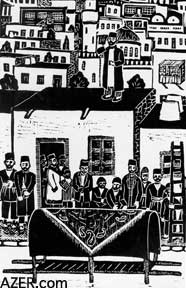  Left: Traditional Funeral service in the Old City.
Molla on rooftop calls to prayer. Left: Traditional Funeral service in the Old City.
Molla on rooftop calls to prayer.
Inner City businessman
Gatir Zeynalabdin Taghiyev (1837-1915), my mother's great-grandfather
(not to be confused with Taghiyev, the famous millionaire), built
a beautiful two-story Baroque-style building to the right of
the Chain House. Unfortunately, that building was torn down in
the 1970s and replaced by a Soviet concrete block structure that
is known as the Encyclopedia Building.
General Tsitsianov
Sarabski provides interesting information about the history of
the Baku fortress gates, which were built between the 12th and
19th centuries. In the 1930s he wrote: "Recently the Inner
City has acquired a fifth gate, though in the past there were
only four. The most famous of the entrances is the Double Fortress
Gates [Gosha Gala], which was sometimes referred to as the Shamakhi
Gate." According to my elderly relatives, in the past there
was only a single archway there at Gosha Gala, not the two entrances
that exist today, which allow traffic to enter and exit through
separate archways. It seems that Russian General Tsitsianov was
set on capturing the Inner City of Baku through the Gosha Gala
gates. In 1806, the Russian navy landed its troops on the shores
of Baku. General Tsitsianov sought permission from Khan Huseingulu
to permit a garrison of 600 to 1,000 Russian soldiers to enter
the city, under the command of Russian authorities.
At first, the khan agreed and even went out to greet Tsitsianov
in front of the Double Fortress Gates. But while the negotiations
were being carried out (February 2), the khan's cousin Ibrahim
suddenly shot Tsitsianov.
Tsitsianov's soldiers fled. The khan's guard tracked down the
Russians and killed many of them. Then the Baku artillery opened
fire on the Czar's ships, which made a hasty retreat to Sara
Island, off the coast of Baku. The khan beheaded Tsitsianov and
then sent his head to the Iranian ruler Fathali Shah as a gift.
Since Russia was at war with Iran, Huseingulu khan hoped to engage
the Shah's assistance in helping him combat the Czar's army.
However, Fathali Shah did not offer any help. Seven months later,
on September 18, 1806, the Russians returned and this time easily
captured Baku. With his 500 soldiers and 70 cannon, the khan
could not withstand the superior Russian forces under Bulgakov.
Huseingulu fled to Ardabil, a city in what is now Southern Azerbaijan
(part of Iran).
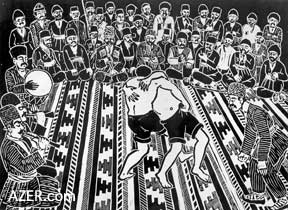  In 1846, the Russians erected a monument
in memory of Tsitsianov, placing it in front of the Double Fortress
Gates where he had been murdered. After the Bolshevik In 1846, the Russians erected a monument
in memory of Tsitsianov, placing it in front of the Double Fortress
Gates where he had been murdered. After the Bolshevik
Left: The Zorkhana-a type of traditional
sports club for men. Wrestling was accompanied by music played
on drums, zurna and balaban.
Revolution in 1920, this monument was dismantled and destroyed
because it honored the Czar's army. During the Soviet period,
Azerbaijani historians avoided mentioning these facts and did
not include the Tsitsianov incident in the "official"
version of the history of Azerbaijan. I happened upon this information
by reading some of the old chronicles that are maintained at
Baku's Institute of Manuscripts, especially a chapter called
"The History of the Baku Khanate," found in the book
"Gullistani-Iram (Garden of Paradise) by the famous scholar
Abbasgulu Agha Bakikhanov (1794-1847), himself a descendant of
that last Baku khan.
Gates and Trade
Sarabski provides interesting
information about another famous gate called the Taghiyev Gate
[located near what is now the Academy of Science Presidium].
He writes: "Another gate is situated close to the Double
Fortress Gates, near the Sabir Square." This gate is not
medieval and was built much later (1877) by the Baku merchant
and landowner Haji Zeynalabdin Taghiyev [a namesake of the famous
millionaire], who had the nickname Gatir Haji Zeynalabdin. Actually,
his nickname relates to this gate. Haji Zeynalabdin owned various
shops where the Sabir Garden and Husi Hajiyev Street are today,
just outside the fortress walls. However, nobody wanted to rent
these shops as they were considered too far on foot from the
bazaar in the Inner City, even though they are part of the heart
of the city today. For quite a long time, Haji's stores remained
empty. Finally, he came up with an idea to ask permission from
the Baku City Council to open a section of the citadel wall and
erect a new gate there.
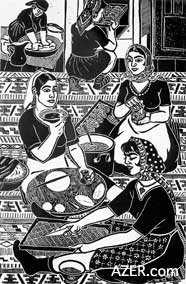  Left:"Novruz Bayrami sweets" for the New
Year (March 21) from the series of prints by Alakbar Rezaguliyev
called "Old Baku", 1966. Here women prepare pakhlava
and shakarbura. Left:"Novruz Bayrami sweets" for the New
Year (March 21) from the series of prints by Alakbar Rezaguliyev
called "Old Baku", 1966. Here women prepare pakhlava
and shakarbura.
Once people from the Inner City were able to pass through this
gate, Haji's shops began to flourish. That's how Haji got the
nickname "Gatir", which refers to his quick wit, resourcefulness
and persistence. (The word "gatir" literally means
"mule", but implies both "smart" and "stubborn".)
According to newspaper accounts, a heated battle took place in
front of the Taghiyev Gate in 1918, when Armenians were trying
to capture the Inner City. Gatir Haji Zeynalabdin's son, Mammad
Hanifa (1875-1920), nicknamed "Gochu" (meaning "brave"),
commanded the Inner City defenders and succeeded in staving off
the Armenians. [See the article "Baku:
City That Oil Built" in AI 10.2 (Summer 2002).]
Sarabski cites very brief information about the other Inner City
gates. The third gate opened into the courtyard of the Industrial
College [now, Azerbaijan State Economic University]. Wheat and
coal were brought from the Absheron village of Navahi and various
mountain villages in carts and camel caravans and then sold there.
The fourth gate was situated behind Baku's City Hall. The fifth
gate opened from the Governor's Garden near the present-day Philharmonic
Hall.
Baku Clans
The native Inner City dwellers belonged to several different
clans, some of which had very humorous names. For example, some
of the more influential clans were named: Agshalvarlilar (those
[men] who wear white trousers), Toyugyeyanlar (chicken-eaters),
Toyugyemayanlar (those who don't eat chicken) and Bozbashlilar
(literally, the gray-headed, implying bald headed). Each clan
often made disparaging jokes about other clans.
My grandmother used to tell me jokes about the "Bozbashlilar".
The word "bozbash" in Azeri also refers to a favorite
Azerbaijani dish, a soup with large meatballs, chickpeas and
sour plums. So, a very fat person from the Bozbashlilar clan
might jokingly be called "the meatball from Bozbash."
A person with a sour disposition might be known as "the
sour plum from Bozbash." A very small person might be called
"the chickpea from Bozbash." These days, the tradition
of dividing residents into clans has disappeared in Ichari Shahar.
Many young people don't even know which clan their grandparents
belonged to.
Nicknames
In the past, it seems everyone who lived in Ichari Shahar had
a nickname. Often the names were quite humorous. For example,
at one time there were five men living in Baku by the name of
Haji Zeynalabdin. They all went by different nicknames. My grandmother
identified them as: (1) Malakesh (Plasterer), (2) Gatir (Clever
and Stubborn), (3) Spasibo (Thank You, in Russian), (4) Nokar
(Servant) and (5) Pendiryemeyen (Cheese-Hater).
The millionaire philanthropist Haji Zeynalabdin Taghiyev got
his nickname, "Plasterer" because as a youth he had
worked as a common day laborer doing masonry work. Supposedly,
one day Taghiyev discovered a clay jar filled with golden coins
plastered into the wall of an old house. He took the gold coins
and sold them, and bought a piece of land that, luckily for him,
had an oil gusher. So, the people nicknamed him Malakesh (Plasterer).
However, Taghiyev himself denied that there was any truth to
this tale. Another Haji Zeynalabdin Taghiyev was nicknamed "Gatir"
(Mule) because he was so smart and persistent in building the
Taghiyev Gate in the citadel wall. Mules are believed to be so
intelligent that they can find water anywhere, even in the desert.
Any person who can make money from "nothing" is often
nicknamed Gatir (Mule).
Writer Manaf Suleymanov tells a curious story about "Gatir"
Haji Zeynalabdin. Haji had a merchant friend who was having trouble
selling a large supply of biscuits (cookies). Haji took a box
of the biscuits and hid his expensive ring inside the box (another
version of the story says it was a five-ruble coin). Then, he
went to the cafe in the Tabriz Hotel, opened the box and began
to munch on the biscuits. Suddenly, he exclaimed: "Look,
what I've found inside the box!" showing off the ring (or
coin) to the people there. People rushed out to buy the biscuits
immediately, and Haji's friend made a huge profit.
The third Haji Zeynalabdin was named "Spasibo" ("Thank
You" in the Russian language). As the story goes, this merchant
found out that Czar Alexander III was planning to visit Baku.
Zeynalabdin decided to play up to him in hopes of receiving a
title, post or medal. Before the Czar arrived, Zeynalabdin repaired
the Russian military barracks in the Inner City with his own
money. The Czar visited the barracks, and afterwards met with
the merchant and told him in Russian, "Spasibo, Zeynalabdin!"
(Thank you, Zeynalabdin!) Then the Czar turned and left, without
bestowing either medal or title. Zeynalabdin had spent enormous
sums of money, but all he got was "Spasibo!" in return!
From then on, Manaf Suleymanov writes, the people living in Ichari
Shahar nicknamed him "Spasibo" Zeynalabdin.
The elderly residents of the Inner City told me that there was
yet another Haji Zeynalabdin who had once been a servant of the
oil baron Haji Zeynalabdin. Gradually, he established his own
business and became wealthy, too. Despite his wealth and newfound
status, the people of the Inner City continued to call him Nokar
Zeynalabdin (Servant Zeynalabdin).
Education
Historical records indicate that a madrasa [a religious secondary
school] was set up in Ichari Shahar in the 11th century. It was
there that the famous Eastern philosopher Baba Kuhi Bakuvi (933-1074)
taught science. Four hundred years later, another distinguished
scholar named Seyid Yahya Bakuvi (died in 1403) founded a Darul-Funun
(university) in the Shirvanshah Palace. However, when the Shirvanshah
state collapsed in 1538 and Baku lost its status as a capital,
these higher-level schools were closed and the cultural life
of the city gradually diminished. The tiny Baku khanate founded
in 1744 could not replicate this sophisticated cultural environment
of an earlier era.
When the Russians descended on Baku in 1806, there were a total
of 12 preliminary and secondary religious schools (maktabs and
madrasas) in the Inner City. According to Sarabski, by the early
1900s, only three remained, and the quality of education had
deteriorated. The common people called these schools "Mollakhana",
meaning "Molla's Home". Some people did not want to
send their boys to the Mollakhana, even for their preliminary
education. They preferred to send them to the less expensive
"private Mollas", who taught only the Arabic alphabet
and the Koran.
Education at the Mollakhanas was based completely upon memorization.
When the youth could not pronounce the Arabic words, they were
beaten with a stick called a "chubug" until they mastered
the pronunciation. Likewise, during the calligraphy lessons,
the teacher would hit the children's fingers when they did not
write correctly. Parents typically supported this approach. When
parents took their sons to the Mollakhana, they used to tell
the Molla: "The flesh is yours, but the bones are mine!"
meaning, "You can beat him, but don't break his bones."
This expression has become an Azerbaijani proverb. In those times,
flogging pupils was common, not only for the Muslim Mollakhanas,
but for the Russian schools as well. Punishment was considered
to be the normal way to make children learn and obey. Before
the Russians came, it was the Mollakhanas who provided the only
education that was available in Baku. Young boys studied the
Arabic alphabet, calligraphy, grammar and arithmetic, and had
to memorize the Koran by heart. Sometimes, they read verses by
Saadi and Hafiz in Persian, and were exposed to a bit of history
from the small tome "Tarikhi-Nadir" (History of Shah
Nadir) and a few other sources.
The musical comedy "O Olmasin, Bu Olsun", (If Not That
One (Bride), Then This One) composed by Uzeyir Hajibeyov in 1911,
provides a humorous reference to this book, "Tarikhi-Nadir".
One of the musical's comic characters, the merchant Mashadi Ibad,
comments on how his friend has sprinkled his conversation with
pretentious words and phrases in Turkish, Russian and French.
"I've read nearly half of 'Tarikhi-Nadir'," Mashadi
Ibad says, "but I still can't understand what you're trying
to say!" The fact that this history text is so small makes
the statement even more humorous.
Water Supply
Since Baku is located on arid land, its residents have always
struggled to have an adequate water supply. [See "Water
- Not a Drop to Drink, How Baku Got its Water" by Ryszard
Zelichowski, "Baku's
Search for Water" by Mammad Mammadov, and "Taghiyev's
Commitment to the Water Problem" by Manaf Suleymanov
in AI 10.2 (Summer 2002). Search at AZER.com.]
Beginning in the 11th century, the Inner City had three underground
water supply systems built of stone and clay pipe. In the 19th
century, this underground pipeline was named Naghi Kuhulu, meaning
"The Pipeline of Naghi"; it served the Inner City residents
until the beginning of the 20th century. The water flowed in
from wells and springs situated throughout the city, then collected
in a special reservoir inside a building named Shirin Ovdan (Sweet
Water House), located near the Shirvanshah Palace.
Sarabski writes that sometimes the pipes of the Ovdan clogged
up, stopping the flow of water. A very kind, skilled person named
Jumru Aghamali always came to the rescue. He was very small,
slender and quick, and could descend into the narrow water pipe
and clean it out.
Sarabski writes: "Jumru Aghamali never asked for any payment
for this work as he believed it was pleasing to God. After Jumru
died, nobody continued his work and the Shirin Ovdan fell into
disuse." Despite Jumru's generosity, he was still labeled
with the nickname "Hezar pesha, kam maya", which means,
"a thousand jobs, little money". Many families tried
to find solutions to the city's water problem by digging their
own private wells in their courtyards. One of the outer walls
of the ovdan used to have a plaque identifying it as: "Medieval
Ovdan. This monument of architecture is under the protection
of the State." However, the plaque no longer stands.
Underground Tunnels
According to medieval sources, there used to be several underground
tunnels located under the Old City. Some of them were constructed
in the 15th century by the Shirvanshahs to serve as escape routes
from the palace complex.
Another underground tunnel was built by Gatir Haji Zeynalabdin
at the beginning of the 20th century, connecting two of his residences:
the one that used to stand where the Encyclopedia Building is
now and another one located on what is now Aziz Aliyev Street
where the Yin Yang Chinese restaurant stands. Haji wanted his
family members to be able to move between the two houses, which
were approximately 100 meters apart on either side of the citadel
wall.
My grandmother told me that she had often walked through this
tunnel during her childhood. During the Bolshevik Revolution,
the owners of these residences fled or were killed. Their buildings
were subdivided into many small apartments, and the tunnels were
forgotten until the 1970s, when archeologists rediscovered the
tunnel, studied it and then went on to other projects, leaving
their excavation work exposed. Somehow thieves figured out that
the tunnel led right up into a jewelry store (now where the Yin
Yang Restaurant is located).
During the night, the thieves secretly began to dig and clean
out this underground tunnel. Eventually, they succeeded in breaking
into the jewelry store and ran off with some precious jewels.
Once the Baku newspapers wrote about the crime, the tunnel was
filled in.
Sports Competitions
One of the Inner City's entertainment areas was the Zorkhana,
a type of stadium where athletic competitions took place. Baku's
Zorkhana dates back to at least the 15th century. Few people
know about it, but this underground vault was located just a
few steps from the Bukhari and Multani caravanserais, towards
the Maiden's Tower.
Similar to sports clubs today, men paid an entrance fee to participate
in various competitions, including weightlifting, wrestling and
boxing. There were contests accompanied by a trio of musicians
who performed traditional Eastern instruments like the kamancha
(stringed instrument), zurna (wind instrument) and naghara (drum).
Most of these melodies have long since been forgotten. However,
one by the name of "Jangi" (War) is still performed
prior to the opening of national wrestling competitions (Gulash).
Young men could test their strength against professional wrestlers
such as those who came from Tabriz, Ardabil, Sarab and other
cities of Southern Azerbaijan (in Iran). Sarabski writes about
one wrestler nicknamed "Altiaylig Abdulali" (Six-Month
Abdulali) who took on all these youth. Before each match, the
famous musician Haji Zeynal Agha Karim would perform a song glorifying
the wrestler. Altiaylig Abdulali would untie his belt, toss his
hat on the floor and come out onto the stage grinning. The young
amateurs approached him one by one. When Altiaylig was finished
wrestling, the spectators would give him various denominations
of money such as three, five or even ten rubles, a considerable
sum of money at the time.
The Zorkhana also functioned somewhat like a fitness club. When
no competitions were taking place, men went there to do exercises
and use sports equipment.
Another competition involved lifting, hurling and catching heavy
millstones. The event was referred to as "Mil Oyunu"
(Millstone Game). The competitors were usually accompanied by
a naghara player, who gradually increased the tempo by beating
the drum faster and faster.
Baku residents also enjoyed attending poetry readings (She'r
Majlislari) and mugham sessions (Mugham Akhshamlari). Poets,
musicians and others often gathered together to perform lyrical
verses (rubai and gazals) and listen to mugham (Eastern modal
music). Food, drinks and sweets were served.
The residents of the Ichari Shahar were fond of "meykhana"
(literally, wine house), an improvisational musical/literary
form common to Baku and its adjacent villages. [See "Meykhana:
Azerbaijan's Own Ancient Version of Rap Reappears" in
AI 4.3 (Autumn 1996).] Meykhana competitions are still popular
in the villages around Baku, although during the Soviet period
they were banned for being too controversial.
Meykhana takes its name from the Eastern pubs where these performances
were carried out. The contest involved two or more poets exchanging
verses back and forth in an extemporaneous fashion, sometimes
joking and disparaging one another. Their rap-like songs often
touched on social and political issues of the time. At the end
of the contest, the audience determined which poet had improvised
the most elegant and clever verses and declared him the winner.
Another favorite pastime among the youth in Baku was raising
pigeons. They would keep scores of pigeons in pigeon lofts, usually
on the roofs of their homes. Every morning, the owners would
climb up on the roof, feed the pigeons and then whistle loudly
to send them off into flight. You can still find a few pigeon
fanciers in the Inner City today.
Nard (backgammon) was a favorite game in the Inner City. Every
family had a set, and the men would often sit and play the game
for hours. Some people also played shatranj (chess) and dama
(checkers).
Children played various games such as Chumrug-Chumrug, Besh-Onbesh,
Usta-Shayird, Dash-Bash, Gizlanpach, Oghru - oghru, Shumagadar
and others that are forgotten now. Of these games, only Gizlanpach
(hide-and-seek) is still widespread today. Banovsha (Violet),
known in other parts of the world as "Red Rover" or
"Octopus Tag", was also a popular game in Ichari Shahar.
Favorite Dishes
The Inner City dwellers liked meat and often referred to it as
"jan" (life). My grandmother once told me a funny proverb
that divided various foods into categories according to their
nutritional value and taste: "Go to the market and buy 'jan'
(life, specifically meat); if 'jan' is not available, buy 'jarimjan'
('half-life', that is, eggs); if 'jarimjan' can't be found, buy
'badimjan' (eggplant, that is, 'poor man's food')".
On holiday mornings, men met their friends in special cafes called
"khashkhana". There they enjoyed "khash",
a hearty, gelatinous soup made from calf's or sheep's feet and
seasoned with vinegar and chopped garlic. Eating khash with friends
was a popular activity back in those days, just as it is today
in Baku. Certain dishes were typical of the Inner City and its
adjacent villages: dushbara (soup made with tiny lamb dumplings),
shorgogal (a round puffed cookie with salt and spices), and chudu,
a puff pastry stuffed with minced meat and sprinkled with sugar
and sumac). These dishes were typically not prepared in other
areas of Azerbaijan.
Traditional Dress
As far as traditional dress and appearance were concerned, each
adult man had to wear a mustache and the national hat ("papag")
on his head. Up until the early 20th century, it was considered
shameful to appear in the street without a mustache, although
Westernized citizens often infringed on this rule. When men were
involved in a serious argument, they would threaten each other:
"I'll cut off your mustache!"
The importance of the hat was emphasized by the following proverb:
"Kishinin papaghi bashinda olar."
A man's hat is always on his head.
The hat was considered to symbolize the man's honor. If someone
touched a man's hat or grabbed it off his head, it was considered
a great affront and could even result in bloodshed.
Baku residents developed a set of traditions in regard to giving
charity to the poor. During the Muslim religious holidays, the
wealthy (and even those who were not so wealthy) would organize
an "Ehsan", or charity dinner for the poor.
My grandmother told me that in those days all of the doors of
her grandfather's home were opened. On the first floor, he filled
long tables with various hot dishes and sweets. Anyone from the
street could come in, sit and eat as much food as he wanted.
The servants took away the empty plates and brought in new dishes.
Hundreds of houses in Baku provided Ehsan during the holidays.
Sometimes the merchants would place the charity tables in the
streets in front of their shops. Back then, if a person seemed
eager to get some food or service without payment, he would be
reprimanded:
Bu saninchun Ehsan deyil.
It's not an Ehsan for you.
Gochus
Gochus were the bullies or gangsters of the Inner City. These
glowering, pompous individuals sported big mustaches, dressed
in national costumes and armed themselves with revolvers and
daggers. When they walked through the city, no one dared confront
them. The average person living in Baku came to fear them very
much. Gochus appeared in Baku at the end of the 19th century,
in response to the Georgian gangsters called "Kintos",
who were engaged in kidnapping and robbery and threatened wealthy
Baku residents.
Since the city's police couldn't deal with the Kintos effectively,
wealthy people began recruiting and arming strong, brave men.
Soon, the Kintos disappeared from Baku, never to return again.
The Baku millionaires saw the effectiveness of the gochus and
began to use them as personal bodyguards. When the businessmen
of the Inner City were involved in a quarrel, they often sent
their gochus out to fight each other. Sometimes this resulted
in a shooting match. It wasn't long until some of these gochu
groups turned into a kind of mafia.
Manaf Suleymanov wrote that a group of gochus kidnapped the famous
Baku millionaire Agha Musa Naghiyev, who was known as a miser.
The gochus demanded 10,000 golden rubles for his release and
threatened to carve him up into little pieces. Agha Musa firmly
replied: "I can pay only 950 rubles. Of course, you can
cut me up into pieces, but then you won't get anything at all."
The gochus understood that Agha Musa would rather die than part
with his 10,000 rubles, so they released him for the ransom that
he had negotiated.
It's important to know that not all gochus were gangsters or
killers or private security agents of millionaires. Some of them
were rich young men who were simply bored at home. Seeking to
have a good time, they would dress up in national costumes, wear
daggers or revolvers and go out into the streets looking for
an adventure, just to show their courage and strength.
Usually, they ended up quarreling with each other and threatening
the poor, helpless people in the streets. For example, they would
approach a very poor man and cuff him on the head, saying things
like: "How is it that you passed me by and did not address
me by saying, 'Hello Sir?'" or "How dare you trim your
mustache?" or "Where's your hat?" or even "Why
do you stand in front of me with such a scowl?"
There were also "good gochus" who protected their communities
from criminals. Curiously, it was the gochus who helped save
the Inner City during the Armenian and Bolshevik massacre of
March 1918, as they were primarily the only armed and organized
Azerbaijanis in the city at that time.
Businessman Teymur Ashurbeyov, who lived in the Outer City, and
Mammad Hanifa Taghiyev from the Inner City mobilized their gochus,
and then rallied and armed many other citizens. They sent these
troops in against the Armenian Dashnak military forces. As a
result, the Inner City and a few streets of the Outer City were
spared from the massacre, while thousands of other Azerbaijanis
were slaughtered elsewhere.
Mulberry Tree
There used to be a very large, old mulberry tree in the Inner
City, located behind the Juma Mosque. People believed that it
was several hundred years old. On hot summer days, men would
sit under it drinking tea and playing backgammon.
The tree was such a well-known landmark that people used to say
things like: "Let's meet at the Mulberry Tree" or "I
live to the left of the Mulberry Tree." A popular song was
even written about this tree as a symbol of the Inner City.
About 25 years ago, the tree was cut down when some construction
work was being done. The local people were very upset about this
loss. Several months later, someone decided to plant a new mulberry
tree there. Back then, Baku residents cared about their city
and wanted to maintain its historical look and landmarks. But
now, the new tree has been cut down, too. There are simply not
enough of the native residents of the Inner City remaining there
who understand its significance.
The history of the Inner City during the first Oil Boom (1850-1920)
is extremely rich and engaging. The memories of Huseingulu Sarabski,
Manaf Suleymanov, as well as the stories of the elder Inner City
residents, the old newspapers and magazines, and many other sources
reveal interesting facts about the history of Baku. These details
must be carefully collected, reconstructed and investigated by
today's historians. Now that the Soviet period has ended, we
have the enormous task of researching the history of our nation
and trying to set the record straight.
Dr. Farid Alakbarov, a frequent
contributor to Azerbaijan International, is chief scientific
officer in the Department of Arabic Manuscripts at Baku's Institute
of Manuscripts. His speciality is researching Azerbaijani manuscripts
written in the Arabic script. To read other articles by Alakbarov,
SEARCH at AZER.com. Several of his articles may also be found
in Azeri Latin at AZERI.org,
a Web site that features Azeri language and literature.
_____
From Azerbaijan
International
(10.3) Autumn 2002.
© Azerbaijan International 2003. All rights reserved.
|







